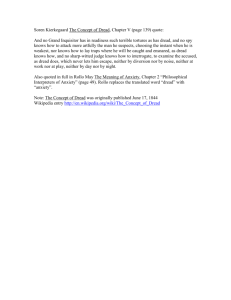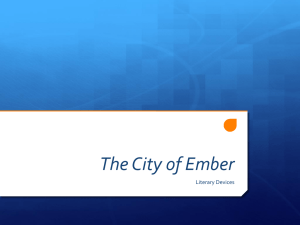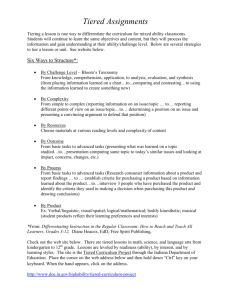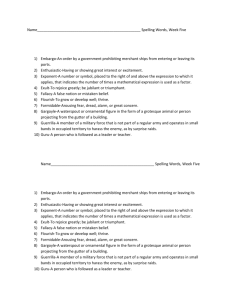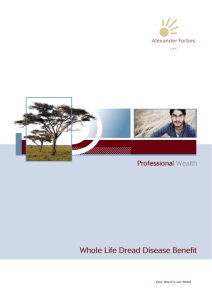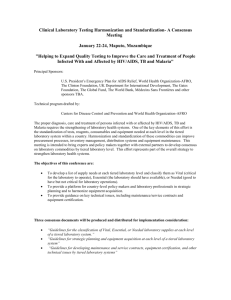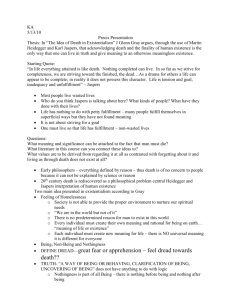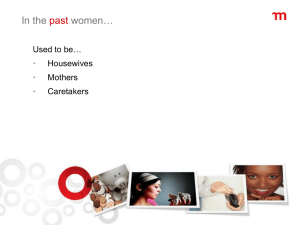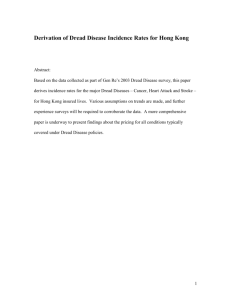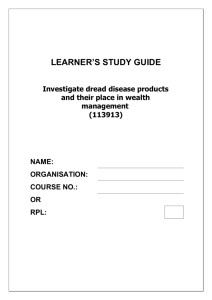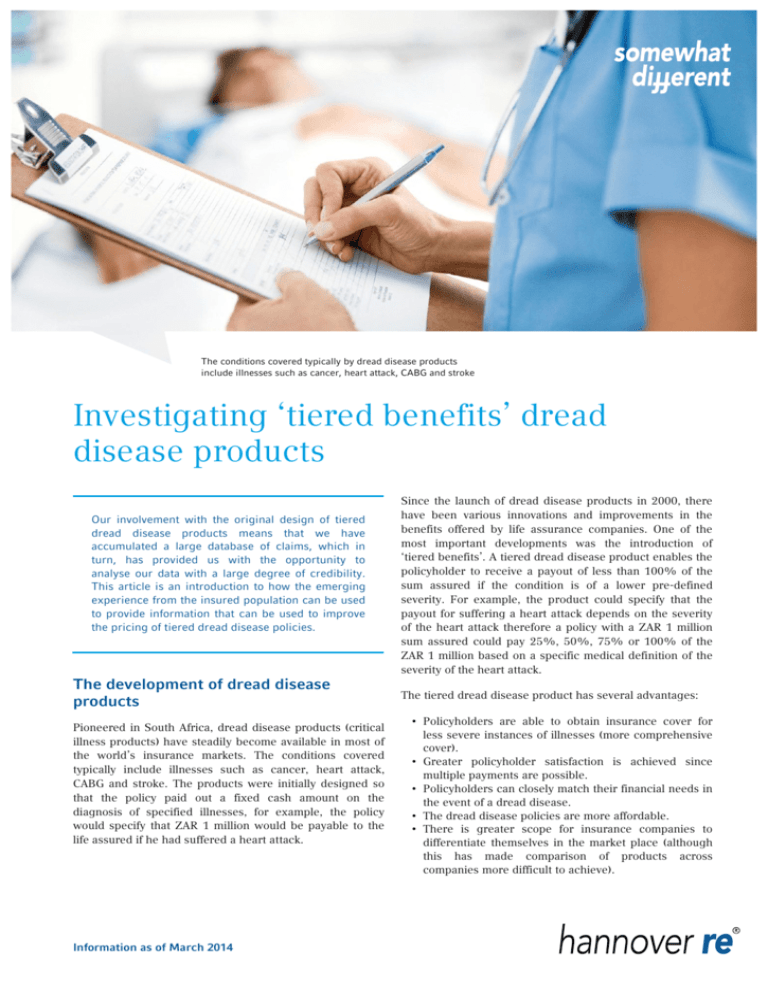
The conditions covered typically by dread disease products
include illnesses such as cancer, heart attack, CABG and stroke
Investigating ‘tiered benefits’ dread
disease products
Our involvement with the original design of tiered
dread disease products means that we have
accumulated a large database of claims, which in
turn, has provided us with the opportunity to
analyse our data with a large degree of credibility.
This article is an introduction to how the emerging
experience from the insured population can be used
to provide information that can be used to improve
the pricing of tiered dread disease policies.
The development of dread disease
products
Pioneered in South Africa, dread disease products (critical
illness products) have steadily become available in most of
the world’s insurance markets. The conditions covered
typically include illnesses such as cancer, heart attack,
CABG and stroke. The products were initially designed so
that the policy paid out a fixed cash amount on the
diagnosis of specified illnesses, for example, the policy
would specify that ZAR 1 million would be payable to the
life assured if he had suffered a heart attack.
Information as of March 2014
Since the launch of dread disease products in 2000, there
have been various innovations and improvements in the
benefits offered by life assurance companies. One of the
most important developments was the introduction of
‘tiered benefits’. A tiered dread disease product enables the
policyholder to receive a payout of less than 100% of the
sum assured if the condition is of a lower pre-defined
severity. For example, the product could specify that the
payout for suffering a heart attack depends on the severity
of the heart attack therefore a policy with a ZAR 1 million
sum assured could pay 25%, 50%, 75% or 100% of the
ZAR 1 million based on a specific medical definition of the
severity of the heart attack.
The tiered dread disease product has several advantages:
• Policyholders are able to obtain insurance cover for
less severe instances of illnesses (more comprehensive
cover).
• Greater policyholder satisfaction is achieved since
multiple payments are possible.
• Policyholders can closely match their financial needs in
the event of a dread disease.
• The dread disease policies are more affordable.
• There is greater scope for insurance companies to
differentiate themselves in the market place (although
this has made comparison of products across
companies more difficult to achieve).
Terminology
CABG: a coronary artery bypass graft
Insured population: the proportion of the country’s
population that have life assurance cover
A stage of cancer: cancer is classified into four
stages. These stages are an indication of the severity
of the cancer and also indicate the extent of the
progression of the cancer. This classification is most
commonly used for solid tumours that arise is an
organ. The exact classification depends on the exact
nature of the cancer.
Stage I cancer: this is confined to the organ where
the cancer originated
Stage II and Stage III cancers: these indicate a
more extensive area of organ involvement or the
cancer has advanced from the point of origin to
involve adjacent structures
Stage IV cancer: where the cancer has spread to a
distant organ or structure in relation to the original
tumour site
Credibility: used in a statistical context, credibility
refers to the reliability of the analyses
The experience of dread disease
products
Traditionally, when determining the price to charge and
setting the premiums for tiered dread disease products,
insurance companies have relied on the results of medical
studies and the opinions of medical and underwriting
experts. This approach was largely due to the absence of
appropriate data relating to the various illnesses covered.
For example, if we consider determining the price to
charge for covering the diagnosis of cancer, we would
require knowledge of the total number of people we would
expect to submit a claim for cancer from the entire insured
population and we would further require data relating to
the number of people that would claim for each of the four
stages of cancer.
At Hannover Life Reassurance Africa Limited we have a
long and deep knowledge of tiered dread disease products
and believe that a benefit of our experience and analysis is
that products will be priced with more confidence and
result in more affordable premiums.
Our analysis specifically considers the pricing of cancer,
but similar questions need to be answered and process
needs to be followed for the other dread disease claim
causes such as heart disease and stroke.
Analysis of the data
Our results are based on dread disease cancer claims that
occurred during the three year period from 2006 to 2008.
Certain claims were excluded from the study because they
either
• relate to policies that do not offer tiered benefits,
• the sum assured of the claim is uncertain, or
• they are progressions of earlier claims (approximately
7% of the observed claims are subsequent claims).
There are in excess of 1,000 cancer claims used in the
analysis of which approximately half relate to male and the
other half to female lives.
Figure 1 shows the percentage of claims in each age group.
The average age at which dread disease claims occurred is
Hannover Re | 2
at ages 49 for males and 45 for females. There are very few
claims observed at ages above 70 (as there is very little
available data at these ages) and therefore these results
should ideally only be applied to ages between 20 and 69
years.
Cancer stages
Females
Figure 3 shows that of the total claims observed in females,
45% are paid in respect of cancers that are diagnosed at
Stage I (and lower). These results are obtained by mapping
the corresponding payout percentages to the product
definitions of the policies included in the analysis. This
information can be used to price the Stage I (and lower)
component of a tiered cancer benefit by using 45% of the
known (total) cancer incidence rate.
Similar pricing calculations are performed based on the
results relating to payments at other levels. As shown in
Figure 3, 23% of the claims were paid for cancers at Stage
II and approximately 32% relate to Stage III or Stage IV
diagnoses.
These results are often different to those from the
population cancer registries maintained by developed
countries such as the SEER data from USA and the UK
cancer statistics. As an example, if we consider only breast
cancer the results from our insured portfolio show that
about 73% of cancers are diagnosed at Stage I or II
compared to 58% observed in lives below age 65 in the
USA population . The results based on the insured portfolio
should be a better reflection of the cancer incidence in the
insured population of South Africa.
Details of the five most frequently occurring types of
cancers for males and females observed in the data are
shown in Figure 2. Skin cancer is the second most common
type of cancer for both males and females, but the
occurrence is significantly less than either breast cancer or
prostate cancer.
Hannover Re | 3
Males
The corresponding results for males are also shown in
Figure 3 and they reflect a broad similarity to the results for
females. Prostate cancer is the main cancer claim type and
38% of claims relate to payments for cancers in Stages III
and IV. This most likely reflects the relative reluctance of
males to seek medical attention at the outset when the early
symptoms are present.
This article is taken from the newsletter Life Trends,
which is published by Hannover Life Reassurance
Africa Limited. We warmly welcome your feedback
by e-mail to:
lifetrends@hannover-re.co.za
© Hannover Life Reassurance Africa Limited. All
rights reserved.
Conclusion
These results illustrate how the pricing of tiered dread
disease benefits can now move away from the numerous
theoretical assumptions. We are now in a position to more
accurately reflect the emerging experience of the relevant
insured portfolios and it is essential that this is done for the
most common causes of dread disease claims in the insured
population because it is more focused, accurate and
appropriate.
The data for claims for the insured population in Africa is
significantly smaller than those relating to populations of
developed countries. Developing pricing information from
smaller datasets gives rise to uncertainty in the results
obtained. However, it is not feasible to ignore the emerging
experience especially when pricing is required for
countries with differing lifestyles and ranges of medical
facilities and services available.
At Hannover Life Reassurance Africa Limited, we
continue to monitor the emergence of the experience
perform investigations to ensure that our partner
assurance companies have access to the most recent
relevant information.
Life Trends
The opinions expressed in this publication are those
of the authors and this publication is subject to
copyright. Apart from any fair dealing for the
purpose of research or private study, no part of this
publication may be reproduced, stored in a retrieval
system or transmitted in any form or by any means
without the prior permission in writing of Hannover
Life Reassurance Africa Limited. Single copies may
be made for the purposes of research or private
study. Multiple copying of the content of this
publication without permission is always illegal.
will
and
life
and
References
1
http://seer.cancer.gov/faststats
Author: Dr. Chessman Wekwete FFA,
Head of Actuarial Pricing & Research,
Hannover Life Reassurance Africa Limited
www.hannover-re.com

